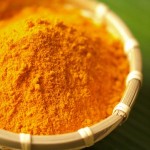 I am a foodie. I’m also an international educator. Put the two together and it means I enjoy reading cookbooks, cooking and of course, eating!
I am a foodie. I’m also an international educator. Put the two together and it means I enjoy reading cookbooks, cooking and of course, eating!
If you know anything about me, you know that I’m also slightly obsessed with India. So, this past week, when I received a copy of The Bengali Five Spice Chronicles – Exploring the Cuisine of Eastern India I was pretty excited! This new cookbook is written by Rinku Bhattacharya, a woman I met when I took her cooking class back in New York. I had asked her to write a blog post about food and culture a few years ago and needless to say, we have stayed in touch.
Grateful for the book arriving just prior to a long holiday weekend, I found myself nestled in my favorite chair reading about the inspirations behind the cookbook (her family – from the past, present and future) as well as the stories of how food plays into the daily life of Bengalis. Rinku grew up in Kolkata but has lived in the US for more than twenty years, so she brings the voice of a Bengali as well as the nuances that a US born American may need to better understand the tools in the cookbook. For example, she provides modifications for shopping and cooking that recognize food preferences, yet still hold true to the important spice profiles of Bengalis.
There is so much to be learned about culture through food and perhaps Rinku describes this best in her remarks about her Indian husband. She says, “I brought home a man who might fringe on satisfying the Bengali love for education but who unfortunately did not speak a word of Bengali. Sadly his Bengali language skills have not progressed, despite being married to me for well over a decade. He does, however, share my passion for food. And I have taught him the joys of savoring a well-made morning cup of Darjeeling tea. I feel that the closest and most practical way I could offer my husband an insight into the Bengali culture was through food.” Thankfully, readers of this cookbook get to learn right alongside Rinku’s husband! (You can purchase it via the link at the end of this post.)
For those of you less obsessed with India than I, let’s begin the cultural lesson by defining where Bengal is! Bengal is in the northeast region of the Indian subcontinent. It is often called the “land of the rivers” because of the Ganges and Brahmaputra rivers that flow through it. The region split apart in 1947 and 1971, first into West Bengal (still part of India) and East Bengal (East Pakistan), and then again when East Bengalis felt that culture and language were stronger than religion that tied them to Pakistan. East Pakistan is now the country of Bangladesh.
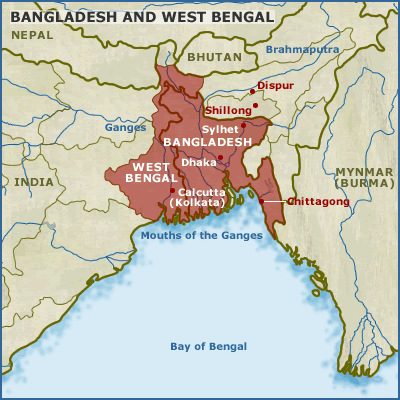
Key to Bengali cooking is what is called panch phoron, the Bengali five spice blend. It is a blend of equal parts of cumin seeds, mustard seeds, nigella seeds, fenugreek seeds, and fennel seeds. You can make the blend yourself or you can purchase the blend from your local Indian store. Here is a blend that I purchased locally (which is spelled Panch Puram here) along with some other key spices :
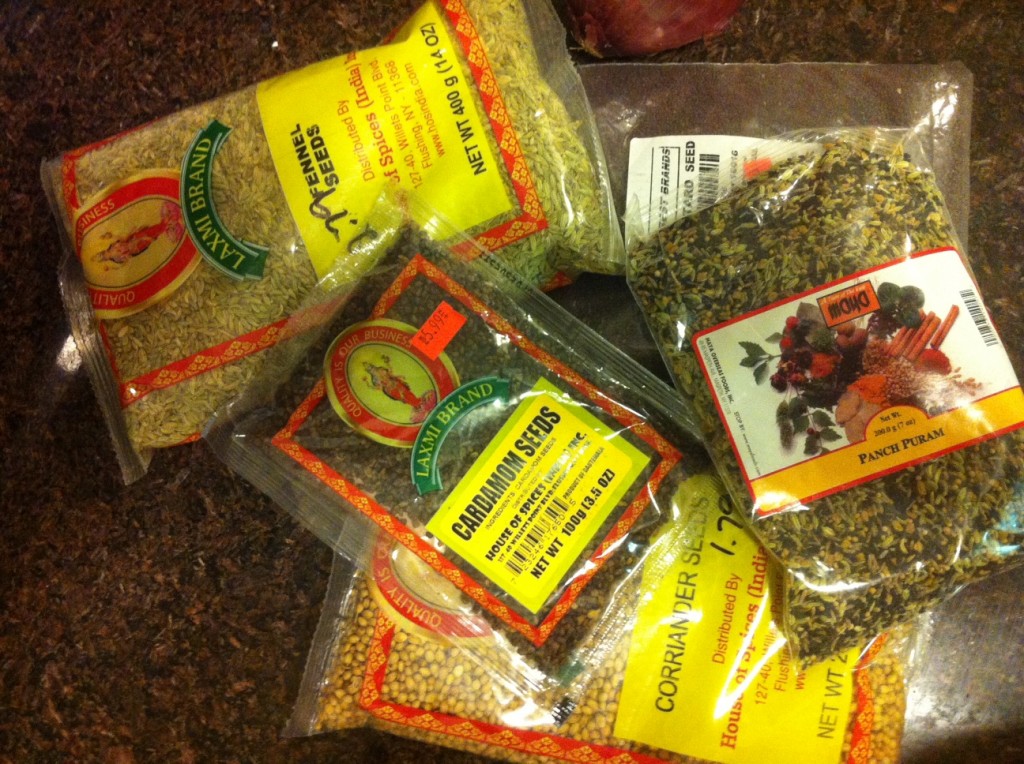
Ironically, my first recipe from this cookbook did not include panch phoron. You see, I had an abundance of radish and cabbage from the farmer’s market in the house and had been seeking a recipe for both – and this cookbook has one on page 113 called Mulor Chechra (Radish and Cabbage – with or without Fish Heads!) I didn’t have a fish head handy, so opted for the “without!”
I’ll share with you the experience of cooking my first Bengali dish. Try not to laugh at me too much – it does get a bit silly and many lessons were learned.
As any experienced cook knows, you should go through the list of ingredients and pull everything you need out of the cupboards to ensure you are prepared. After a visit to the India store in town, I thought I was well prepared! I even made sure to get the mustard oil required for the recipe.
Lesson #1: Read the labels, even when the shop keeper brings you to the section for mustard oil. Why? Read closely:
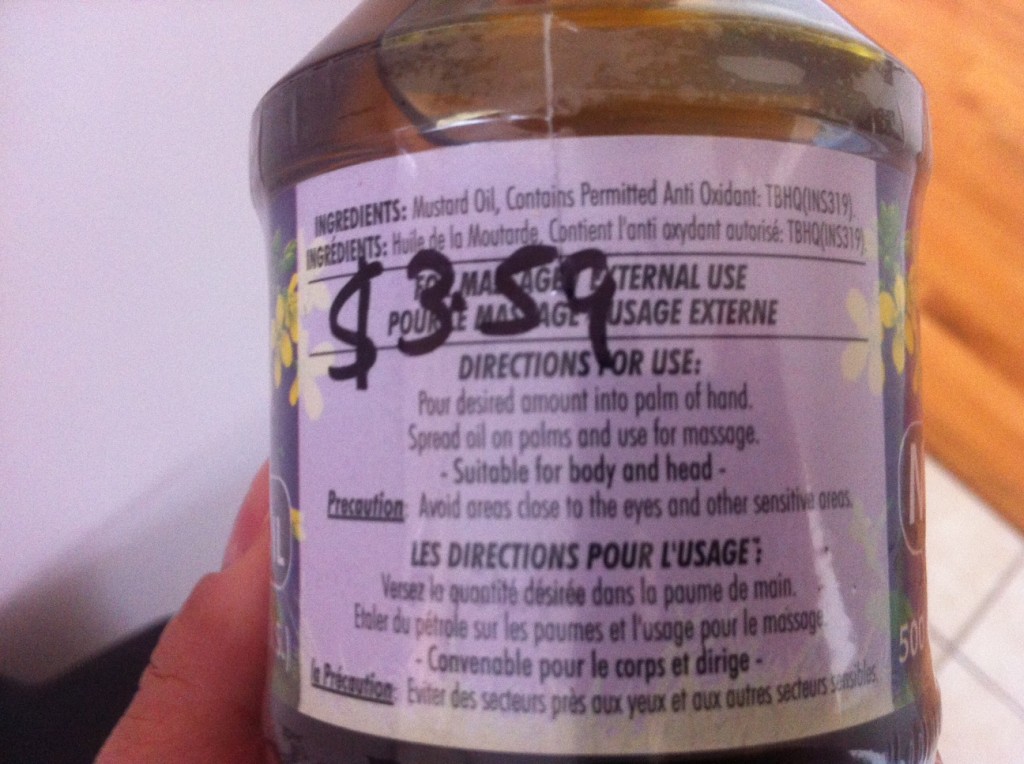
Yup. You see it. The part that says “Spread oil on hands and use for massage. Suitable for body and head.” Seriously, I almost put that in my food! So, be sure to read the label when you think you’re buying what is “obviously” a cooking oil! Being the “agile interculturalist” that I am, I substituted canola oil. (Are you laughing yet?)
Before even going down the path of putting a pan on the stove, I did take the time to blend my first spice mix needed for this recipe called “Ada Dhone Jire Bata.” This is a ginger-cumin-coriander paste that also includes some green chilies.
Lesson #2: When the book suggests using a coffee grinder, be a big person and go out and buy one. I decided that the blender would probably be “just fine.” Ok, it really wasn’t. My paste was rather lumpy because the blender kept spitting the spices up to the top of the lid and it really required much more work to keep pushing the unblended coriander and cumin back down near the blade. But alas, it was sufficient enough to continue.
Lesson #3: When putting hot chilies into a blender and opening it and sticking your face near it to see how blended it is, note that you may actually get some of the heat from the chilies into your nose and mouth, causing a slightly nagging cough for a few minutes. Not to worry, lesson learned quickly and you will be fine after a couple of sips of water!
Moving right along, I got the “paste” ready and carefully followed the instructions. Until I realized I forgot to pick up some squash. I decided instead to double up on the spinach or Swiss chard, until I realized that I only some other fun (nameless) greens from the farmer’s market and used twice the amount of those instead of the recommended spinach or Swiss chard. (Don’t get discouraged here – it still came out delicious!)
I proceeded to heat the paste in the oil and then tossed in the vegetables. I was so happy to see that there is a recipe that includes cooking radishes, as I had only had them before in raw salads. Here is the spice mix and then the veggies before the cooked down:
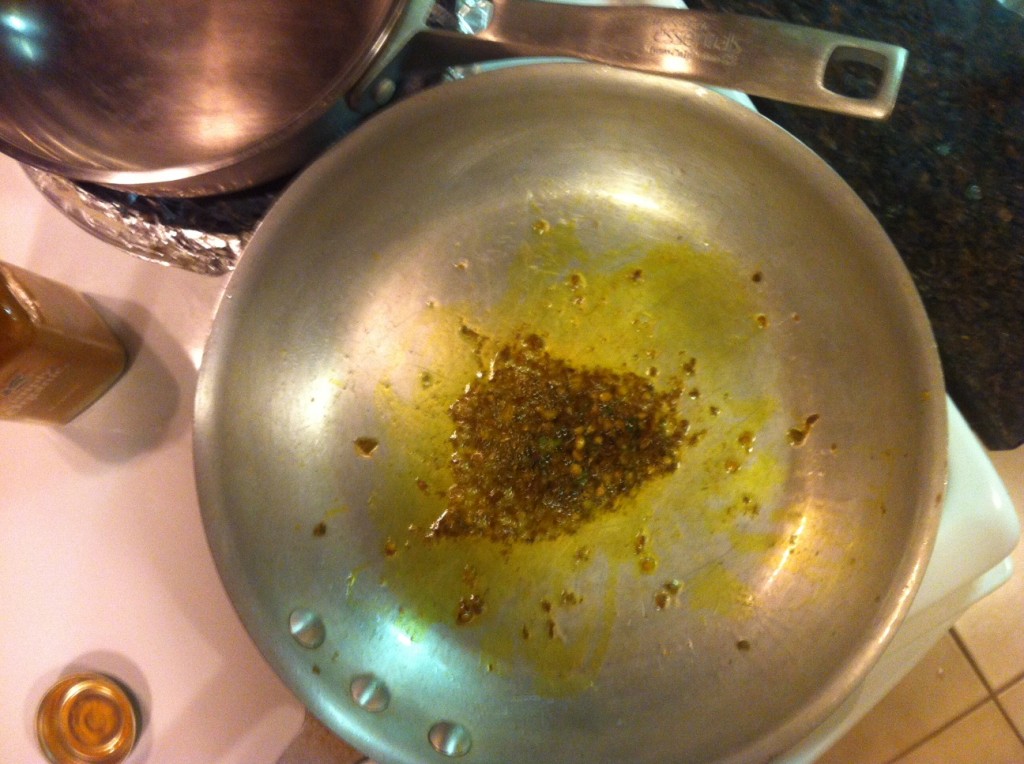
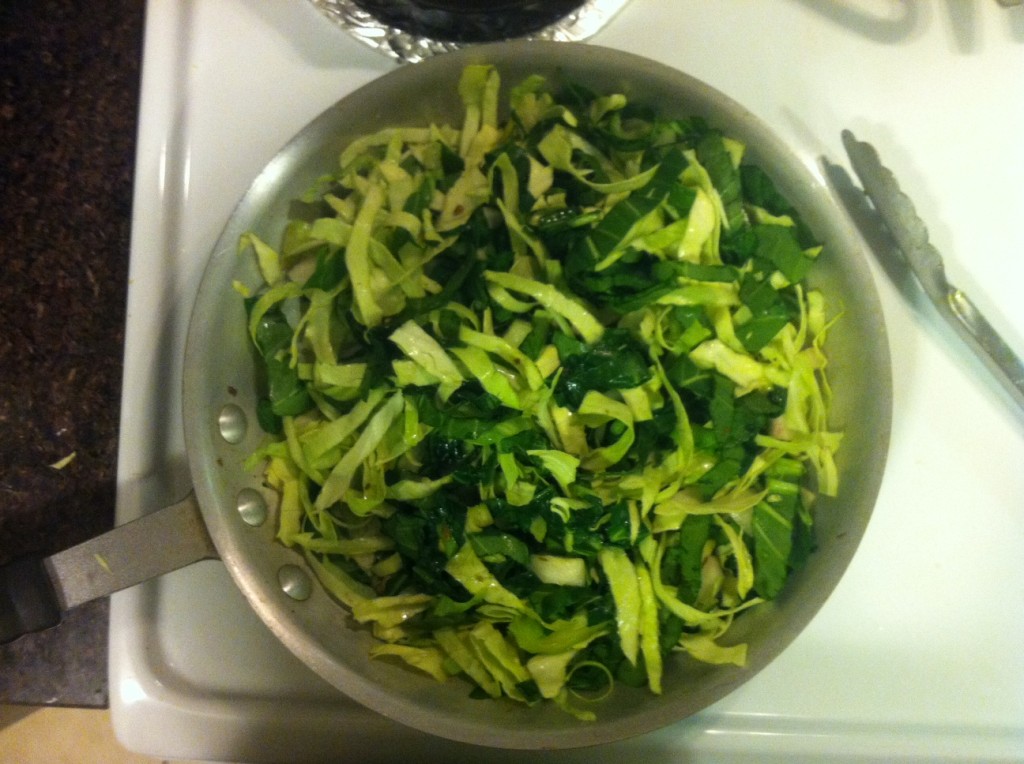
I then set up another pan for the required ghee (clarified butter) and bay leaf combination, fried the bay leaves as instructed and poured them over the veggies.
This is where Lesson #4 occurs: Make sure you have a second set of hands available to take the photos when you are cooking – and especially pouring hot ghee into another pan. While I didn’t spill it all over the floor, I did manage to take a pretty blurry photo!
Note that the veggies are absorbing the fabulous spice blend and they are softening as they cook over the fifteen minutes. I so wish that WordPress would add an “insert scent” button next to the “insert media” button so I could share the incredible smell coming out of my kitchen!
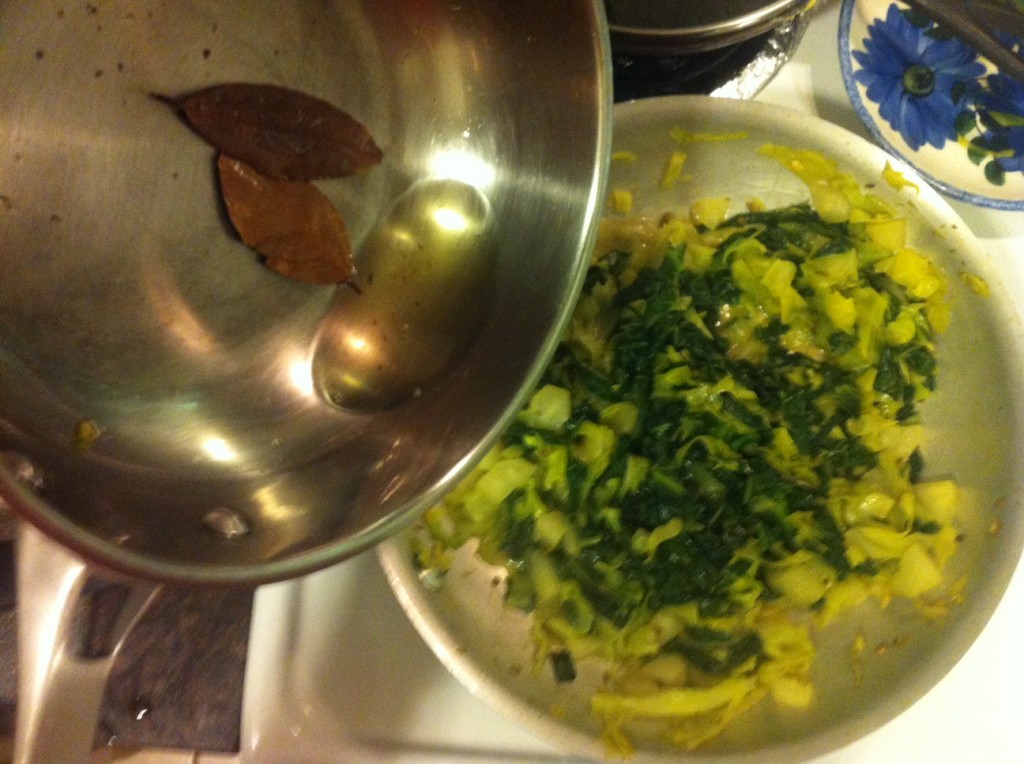
The finished dish, despite my various screws ups was still delicious. I’ve explored many ways to cook cabbage and this was, by far, the most tasty. The radishes became comfort food – they lost that sharpness and instead absorbed the delicious spice blend (and tumeric, which the recipe also called for.) I think it would have been even better had I been more generous with the chilies and pepper powder. I will be sure to do so next time, along with purchasing an actual edible mustard oil!
This is the final dish, which I photographed alongside Rinku’s book: 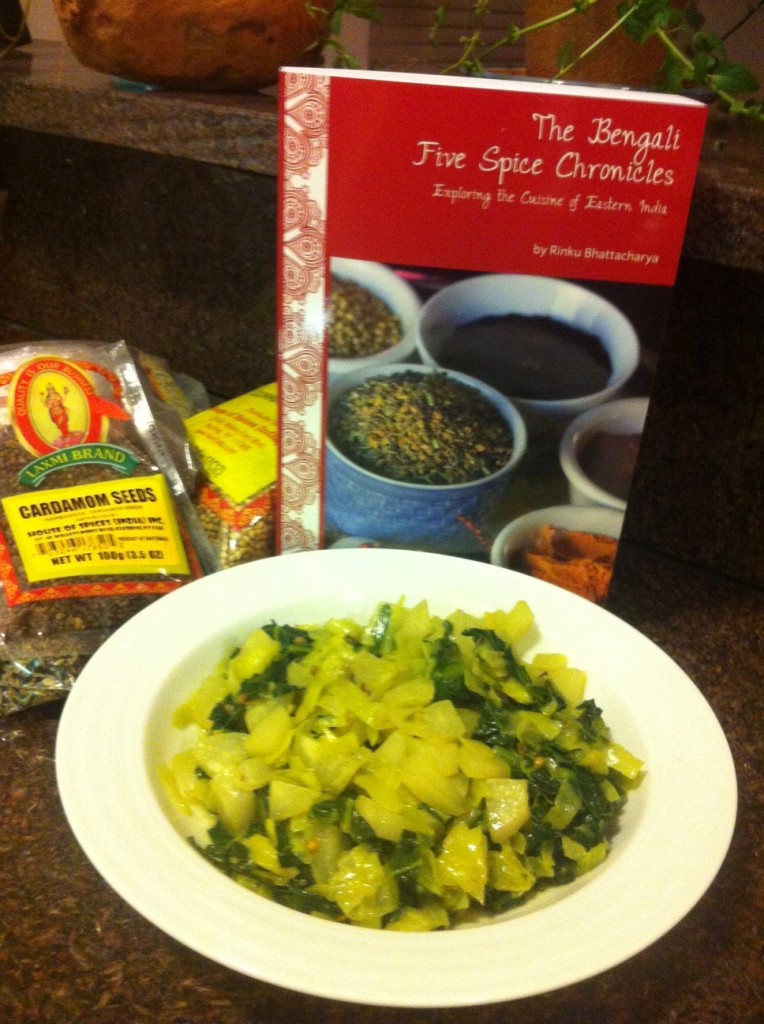
Like Rinku, I put my own spin on the recipe the following morning when I made breakfast. I added elements of a typical American breakfast by cooking a fried egg and some sausage patties to accompany the Mulor Chechra. Since I didn’t have a fish head to enhance this dish, I used my own pantry of protein instead!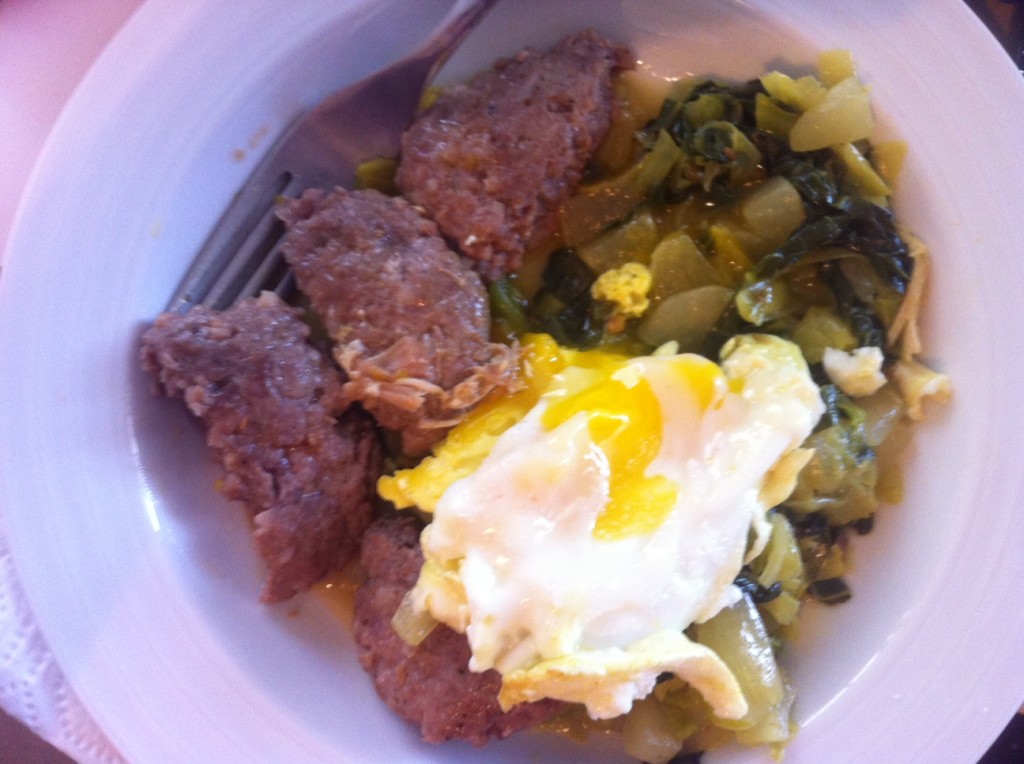
I’m looking forward to exploring this cookbook further, especially the chapters on eggs and sweets (apparently many Bengali desserts utilize milk.) There are many stories of how food relates to Bengali culture peppered throughout this cookbook. It is an education and a feast all in one well priced and well written cookbook. I am especially grateful for it because there are few English language cookbook options about Bengali cooking that are as comprehensive as this one. As a person who doesn’t eat gluten, I can see that there are countless options for foods that I can cook and eat without worrying about gluten exposure.
Many thanks to Rinku for her contribution to the foodie/culture/education arena! If you’re interested, you can purchase the book below.
(Disclosure: I received a free copy of the cookbook, at my request, from the publishing company, Hippocrene Books. However, I am not being paid to write about this book by Rinku or the publishing company.)


Now this brought a huge smile to my face. I spent half of December eating my way from Calcutta to Darjeeling. Fish? Spectacular. Chaat? Mezmerizing.Food in general? More, please.
Glad you had fun with it. I had fun with your caveats.
Three cheers for more fine dining from the comfort of your own kitchen. Just recently learned how to make dokla.Simple. Fun. Delicious.
So glad to hear! It was a great experience and I need to tackle a few more recipes once I get the spice grinder. Needless to say, I’m WAY jealous about your eating holiday. J-E-A-L-O-U-S! Do you ever cook, or do you just focus on the eating my friend? Miss you!